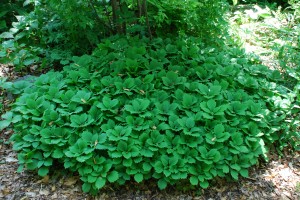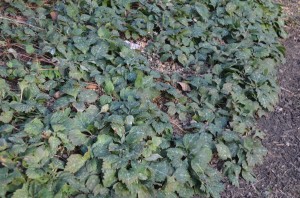Japanese pachysandra (Pachysandra terminalis) is a popular ground cover for partly shaded landscape areas. Our native pachsandra, called Allegheny spurge (P. procumbens), is less known and utilized.
The glossy dark evergreen leaves are wider than Japanese pachysandra. Clusters of white bottlebrush flowers emerge 2-4 inches high in early spring; flowers mature pale pink as new mid-spring foliage emerges. Leaves take on a mottled, matted green look in late summer. The foliage mats down to retard soil erosion on slopes and to crowd out competing weeds.
Individual plants tend to clump or mound and grow 50% slower than their Asian kin. Japanese pachysandra is winter hardier (USDA hardiness zone 4) compared to Allegheny spurge (zone 5). Both grow well under shade trees, particularly where ornamental grasses tend not to prosper.
Allegheny spurge likes a slightly acidic (pH 5.6 – 6.6), moist, well-drained soil. In USDA zone 6 and further south, full day sunlight tends to burn the foliage. Before planting amend the ground with generous amounts of sphagnum peat or compost. Apply a slow-release 10-10-10 fertilizer once in early spring; or use a water-soluble fertilizer designated for acid-loving plants and apply 2-3 times over the season, but no later than late August.
Over its initial two years, irrigate native spurge to get a good start. Leaf spot diseases are rarely problematic unless plants are frequently watered overhead. It mixes well with other shade perennials such as bleeding hearts (Dicentra), lungworts (Pulmonaria), dwarf Solomon seals (Polygonatum), brunneras, and assorted ferns.



 Posted in
Posted in 
